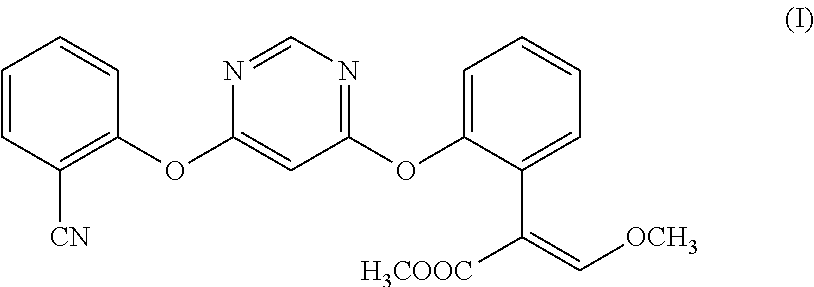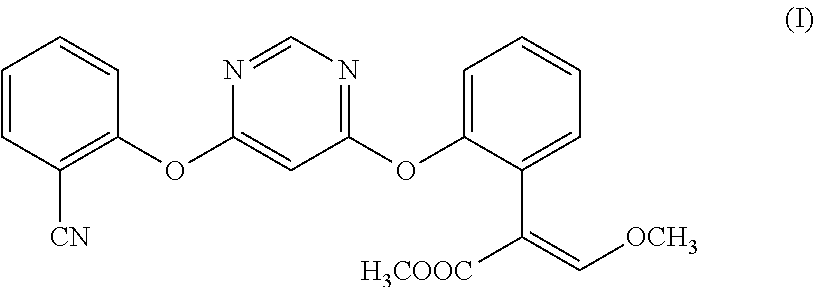Process for preparation of azoxystrobin and intermediates thereof
a technology of azoxystrobin and intermediates, which is applied in the field of process for the preparation of strobilurin compound, to achieve the effect of improving the purity of azoxystrobin and reducing the impurity
- Summary
- Abstract
- Description
- Claims
- Application Information
AI Technical Summary
Benefits of technology
Problems solved by technology
Method used
Image
Examples
example 1
[0199]Preparation of methyl (E)-2-{2-[6-chloropyrimidin-4-yloxy]phenyl}-3-methoxyacrylate (compound IIa)
[0200]To a stirred mixture of 3-(methoxy methylene)-2(3H)-benzofuranone (97%, 91 g, 0.5 moles) in methyl formate (275 g), 4,6-dichloropyrimidine (98%, 92 g, 0.605 moles) was added at 10° C. 1,8-diazabicyclo [5,4.0]undec-7-ene (0.038 g, 0.249 mmol, 0.05 mole %) was added to the above reaction mixture followed by drop-wise addition of sodium methoxide (30%, 110 g, 0.61 moles) in methanol at 10 to 15° C. After addition was over, the reaction mass was maintained at 10 to 15° C. for 1 hour. Methyl formate was then distilled off from the mixture while maintaining the temperature below 55° C. Toluene (300 ml) and water (200 ml) were added to the remaining residue and the mixture was stirred at 60-65° C. The mixture was cooled to room temperature and the organic layer was separated. Toluene was distilled off under reduced pressure and the oily residue was heated to 130-135° C. Potassium h...
example 2
Preparation of methyl (E)-2-{2-[6-chloropyrimidin-4-yloxy]phenyl}-3-methoxyacrylate (Compound IIa)
[0201]To a stirred mixture of 3-(methoxy methylene)-2(3H)-benzofuranone (97%, 91 g, 0.5 moles) in methyl formate (275 g), 4,6-dichloropyrimidine (98%, 92 g, 0.605 moles) was added at 10° C. 1,5-diazabicyclo [4.3.0]non-5-ene (0.031 g, 0.249 mmol, 0.05 mole %) was added to the reaction mixture followed by drop-wise addition of sodium methoxide (30% in methanol 110 g, 0.61 moles) at 10 to 15° C. The reaction mass was maintained at 10 to 15° C. for 1 hour. Methyl formate was then distilled off while maintaining the temperature below 55° C. Toluene (300 ml) and water (200 ml) were added to the residue and the mixture was stirred at 60-65° C. The mixture was cooled to room temperature and the organic layer was separated. Toluene was distilled off under reduced pressure and the oily residue was heated to130-135° C. Potassium hydrogen sulphate (1.36 g, 0.01 moles) was added and the reaction mix...
example 4
[0204]Preparation of azoxystrobin (Compound I)
[0205]To a stirred mixture of methyl (E)-2-{2-[6-chloropyrimidin-4-yloxy]phenyl}-3-methoxyacrylate (83.5 g, 0.25 moles), potassium carbonate (52.8 g, 0.375 moles) and 2-cyanophenol (33.8 g, 0.275 moles) in DMF (170 g), 1,8-diazabicyclo [5,4.0]undec-7-ene (0.76 g, 0.005 moles, 0.02 mole %) in DMF (10 ml) was added at room temperature. The mixture was heated to 90° C. and stirred at same temperature for 7-8 hours. The reaction mixture was cooled to 50-55° C. and filtered to remove the salt. The filtrate was subjected to distillation to recover DMF at 70-80° C. under vacuum. The residual mass was crystalized from mixture of methanol (90 ml) and water (10 ml) to obtain the titled product (purity: 99.4%, dimer content: 0.05%).
PUM
 Login to View More
Login to View More Abstract
Description
Claims
Application Information
 Login to View More
Login to View More - R&D
- Intellectual Property
- Life Sciences
- Materials
- Tech Scout
- Unparalleled Data Quality
- Higher Quality Content
- 60% Fewer Hallucinations
Browse by: Latest US Patents, China's latest patents, Technical Efficacy Thesaurus, Application Domain, Technology Topic, Popular Technical Reports.
© 2025 PatSnap. All rights reserved.Legal|Privacy policy|Modern Slavery Act Transparency Statement|Sitemap|About US| Contact US: help@patsnap.com



